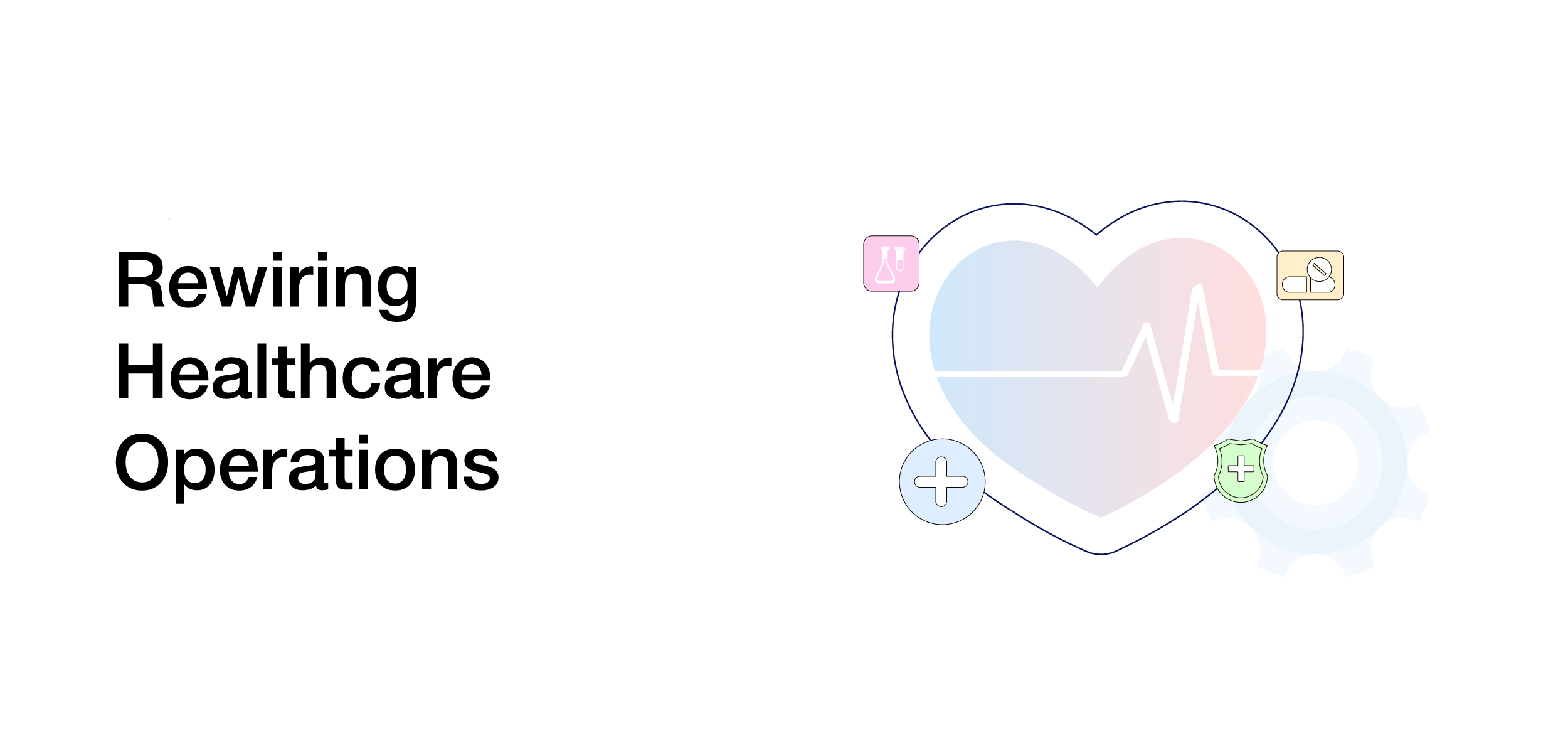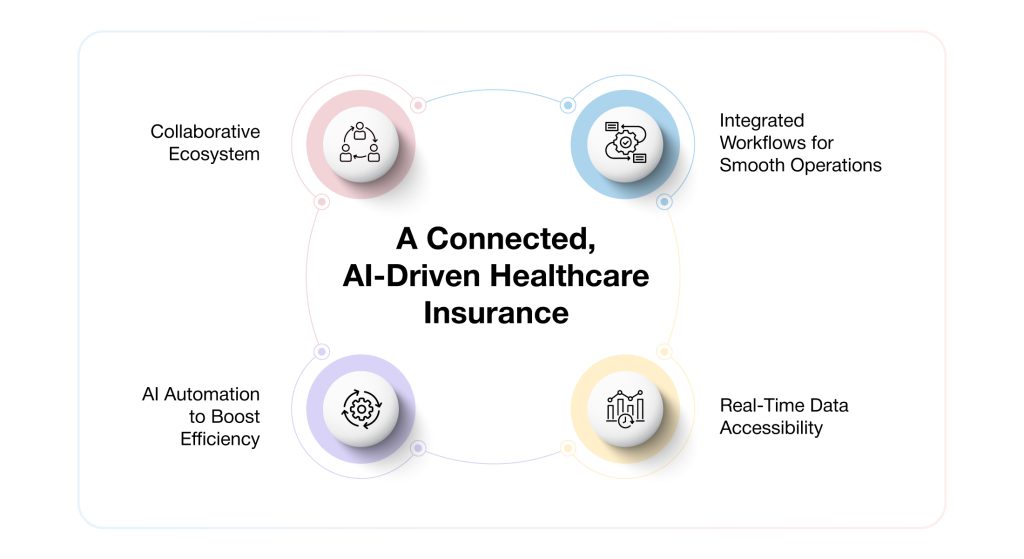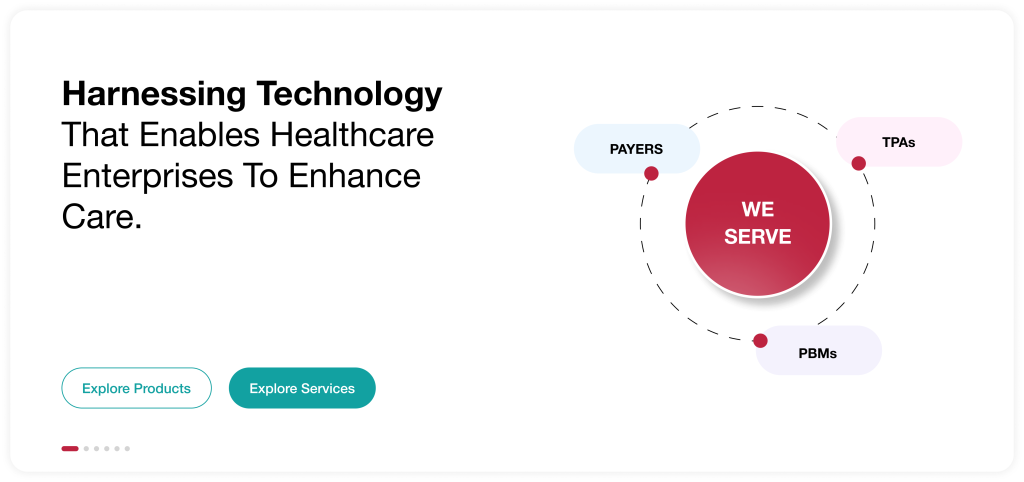
In today’s fast-paced healthcare insurance environment, outdated systems and fragmented data aren’t just operational inefficiencies—they’re serious business risks. With rising competition, evolving regulations, and growing member expectations, enterprises can no longer afford to depend on siloed legacy infrastructure.
AI-driven platforms like VIZCare Empower are transforming the way healthcare operations are. By seamlessly connecting business functions and enabling real-time, data-driven decision-making, these platforms drive operational efficiency in healthcare, elevate member satisfaction, and accelerate overall business growth.
In this blog, we’ll examine how disconnected systems are quietly draining profit margins, slowing down critical processes, and creating barriers to scalability for healthcare enterprises. We’ll also explore how adopting AI-powered solutions can help streamline workflows, reduce costs, and boost profitability, ensuring enterprises stay ahead in an increasingly complex and competitive healthcare landscape.
The Silent Drain: How Fragmented Healthcare Insurance Operations Are Bleeding The Margins
In the healthcare insurance industry, fragmented systems do more than slow things down—they quietly drain profitability. Outdated tools, manual workarounds, and disconnected workflows introduce hidden costs that accumulate over time, steadily eroding margins and hindering long-term growth. What seems like minor inefficiency today can snowball into major financial strain tomorrow.
Have Legacy Systems Become A Costly Burden?
Nearly 70% of annual IT spending by U.S. insurers goes toward maintaining legacy systems, leaving limited capacity for innovation. By adopting integrated, AI-powered platforms, insurers can shift resources from upkeep to transformation. In a market where agility is key, relying on outdated infrastructure puts enterprises at a serious disadvantage.
The greater the dependence on legacy systems, the more insurers restrict their ability to innovate and improve service delivery.
Behind the Scenes Chaos: Why Disjointed Systems Are Failing Healthcare Insurance
Fragmented systems in healthcare insurance affect more than just customer experience—they lead to mounting operational inefficiencies, increased costs, and greater compliance challenges. Disjointed platforms and siloed data flows not only frustrate members but also directly impede insurers’ ability to scale, particularly when integrating with providers and managing complex TPA workflows.
Here’s a closer look at how these structural challenges are constraining the industry’s growth:

1. Lack of Visibility Across Operations: When systems fail to talk to each other, critical business functions—such as sales, claims, underwriting, and customer service—end up operating in silos. Without a unified view of the member journey or claim lifecycle, business teams are forced to duplicate efforts, chase down updates, and make decisions based on incomplete information. The result is increased delays, higher error rates, and reduced productivity across the enterprise.
2. Slow Onboarding: Onboarding new members or employer groups often requires re-entering the same data across multiple disconnected platforms. This fragmented workflow slows enrollment, increases the risk of data entry errors, and leads to longer wait times before members can access their benefits. Instead of delivering value, insurers spend valuable time and resources reconciling discrepancies and resolving preventable issues.
3. Inefficient Customer Service: When contact center agents lack real-time access to complete consumer profiles, even simple queries become drawn-out investigations. Agents are forced to toggle between systems or escalate cases unnecessarily, delaying issue resolutions, increasing service costs, and eroding member trust and satisfaction.
4. Cumbersome Compliance Tracking: Scattered data makes compliance tracking manual, reactive, and error-prone. As regulations evolve (HIPAA, SOC 2, CMS), insurers face mounting difficulty in generating timely reports or verifying adherence, exposing them to penalties, slowing audits, and stalling innovation.
The Domino Effect: From Inefficiencies To Business Risks
We’ve examined the day-to-day operational disruptions caused by fragmented systems—limited visibility, slow onboarding, and inconsistent customer service. However, beneath these challenges lies a more critical business reality: disjointed systems don’t just delay processes—they jeopardize overall business growth.
Let’s take a closer look at the broader, cascading risks threatening the long-term health and competitiveness of healthcare insurance enterprises :
1. Margin Erosion: The Silent Profit Killer
Behind every manual task, outdated tool, and fragmented process lies a hidden cost. Disconnected systems prolong timelines for critical healthcare operations such as claims processing, underwriting, and enrollment, requiring additional resources for tasks that should be efficient and streamlined.
Over time, these inefficiencies compound, driving up operational costs and eroding profit margins. According to a recent report by McKinsey, modernizing core systems can deliver up to 30% cost savings for payers within five years.
The takeaway is clear: healthcare automation and interoperability are vital components for maintaining healthy profit margins for healthcare insurance enterprises.
2. Member Churn: When Frustration Becomes Attrition
Disconnected systems don’t just undermine service quality—they erode long-term member trust. Today’s members expect fast, transparent, and personalized experiences. When faced with repeated delays, inconsistent information, or unexplained claim denials, their loyalty rapidly declines.
A 2024 consumer survey revealed that 43% of respondents identified claim processing delays as their primary frustration, while poor service was their leading cause of provider switching. Therefore, member churn is far more than a missed opportunity—it constitutes a significant revenue loss with measurable business impact.
3. Compliance Threats: Risking More Than Just Penalties
In a highly regulated industry like healthcare insurance, compliance is non-negotiable. Yet fragmented systems hinder the ability to track, audit, and report data in real time, significantly increasing the risk of regulatory violations and financial penalties.
Without a unified view of data and processes, insurers face ongoing challenges in keeping pace with evolving mandates such as HIPAA, SOC 2, and CMS requirements. Beyond monetary fines, non-compliance can damage brand reputation and strain critical relationships with providers and regulators alike.
4. Stunted Scalability & Innovation: Growth At A Standstill
Today’s insurers must be agile—capable of responding swiftly to new regulations, entering emerging markets, and meeting evolving member expectations. However, legacy systems and manual workflows continue to constrain speed, adaptability, and innovation.
Whether the goal is to launch new products, expand into new regions, or scale operations, success depends on a modern, connected infrastructure. Disconnected systems don’t merely slow progress—they leave insurers unprepared for the demands of the future.
Operational inefficiencies are no longer confined to the back office—they have become front-line business risks. From margin pressure and compliance threats to member attrition and stalled innovation, the cost of fragmentation is simply too high to ignore.
For insurers aiming to drive long-term growth, build member trust, and lead in a competitive market, the path forward starts with connected, intelligent systems that enable agility and resilience at scale.
Blueprint For Change: What A Connected, AI-Driven Healthcare Insurance Platform Looks Like
For enterprises aiming not just to keep pace, but to lead in a rapidly evolving healthcare insurance landscape, modernization is no longer optional—it’s a strategic imperative. AI-powered, integrated platforms are transforming operations, enabling faster decision-making, smarter workflows, and deeper member engagement.
Here’s what a future-ready blueprint looks like

1. Integrated Workflows For Seamless Operations
A connected healthcare insurance platform eliminates silos by unifying workflows across sales, onboarding, claims, and customer service. This seamless integration ensures that data flows efficiently across business functions, reducing friction and enhancing coordination.
Integrated workflows enable enterprises to minimize duplication, accelerate decision-making, and significantly improve operational efficiency. For example, real-time updates on member status become immediately accessible to all relevant teams—reducing delays, increasing responsiveness, and streamlining service delivery. By eliminating manual handoffs and minimizing errors, integrated systems also help drive down operational costs.
2. Real-Time Data Accessibility To Drive Compliance & Precision
Accurate, real-time data is essential for managing risk and ensuring regulatory compliance. AI-powered healthcare insurance platforms provide a unified view of members, policies, and claims—enabling teams to proactively monitor compliance requirements and respond swiftly to potential issues.
This level of transparency reduces the risk of non-compliance penalties, improves decision accuracy, and simplifies audits. With immediate access to reliable data, insurers can maintain precision and stay ahead of evolving regulatory demands.
3. AI Automation To Boost Efficiency
AI-driven healthcare automation streamlines operations by eliminating time-consuming, repetitive tasks—from auto-generating documents to pre-validating claims and verifying member benefits. This allows human teams to focus on handling exceptions, managing escalations, and driving strategic initiatives.
Even more impactful, AI-powered predictive analytics can anticipate member needs, personalize outreach, and improve satisfaction—ultimately helping to reduce churn and foster long-term loyalty.
4. Collaborative Ecosystem For Cross-Functional Agility
Modern platforms foster a shared workspace where teams collaborate via unified dashboards, messaging tools, and workflow boards. With everyone aligned on goals and timelines, insurers can deliver faster, more coordinated service.
This cross-functional visibility ensures a consistent member experience across every touchpoint – boosting trust and operational harmony.
Insurance Operations Made Easy: A Working Example with AI
Consider a U.S. based health insurer grappling with a common industry challenge: fragmented systems. Claims, customer service, and sales teams each operate on separate platforms, leading to disconnected workflows, inconsistent data, and a frustrating member experience.
When a member files a claim, support agents lack real-time visibility into the member’s current plan status. As a result, delays increase, miscommunications multiply, and member satisfaction suffers.
Now, imagine an alternative scenario. The insurer adopts an AI-powered, fully integrated healthcare platform—delivering immediate and measurable improvements.
1. Integrated Workflows Across The Enterprise
Sales, onboarding, claims, and customer service now operate on a unified platform. Member updates—such as address changes or newly added dependents—automatically sync across all functions, eliminating the need for manual rechecks.
For instance, when a claim is submitted, support agents can instantly verify its status without switching systems or escalating inquiries. This real-time visibility reduces errors, accelerates response times, and significantly enhances the member experience.
2. Real-Time Data Accessibility For Every Function
The platform equips every team with secure, real-time access to up-to-date plan details, claims data, and compliance information. Whether responding to regulatory changes or tracking eligibility thresholds, teams remain informed, aligned, and agile.
When a new state regulation requires additional documentation for certain claims, the AI system proactively flags the requirement and routes alerts to the appropriate teams—ensuring compliance without disruption.
3. AI Automation For Smarter Work, Faster Results
Routine tasks such as document generation, claims validation, and benefit verification are now fully automated—freeing up teams to focus on complex cases and member engagement.
By analyzing historical data, the platform identifies patterns and anticipates member needs—enabling more personalized support, proactive outreach, and a superior overall experience.
4. A Truly Collaborative Team Environment
Shared dashboards foster cross-functional collaboration. Plan details needed during a sales call or claims updates required during a service interaction are readily accessible. Every stakeholder has access to the same real-time data—eliminating handoffs and delays.
This level of transparency ensures consistent messaging, coordinated responses, and a seamless experience across every member touchpoint.
VIZCare Empower: The Platform That Bridges Healthcare Insurance Silos

In today’s complex healthcare insurance landscape, siloed systems undermine efficiency, compromise member experience, and increase compliance risk. To remain competitive and compliant, health insurers must unify operations and streamline workflows across the enterprise.
Enter VIZCare Empower, an AI-powered platform purpose-built to eliminate fragmentation and drive end-to-end operational transformation.
From sales and onboarding to renewals and contact center support, VIZCare Empower connects every business function with intelligence, speed, and precision.
1. End-To-End Sales Management: VIZCare Empower gives teams real-time visibility into broker activities, progress, and support needs—enabling timely, personalized assistance, faster deal closures, and improved broker satisfaction. The platform streamlines the entire broker journey, from quoting and contract signing to enrollment, all within a single, unified interface.
2. Business Process Automation And Workflow Management: VIZCare Empower offers an intuitive drag-and-drop interface, allowing healthcare teams to build and modify workflows without technical expertise. It integrates seamlessly with existing systems and scales effortlessly with the business. As needs evolve, teams can quickly update workflows to stay agile and efficient.
3. Seamless Onboarding Of Groups And Individuals: VIZCare Empower streamlines end-to-end onboarding for new clients and employer groups. With intuitive tools, automated configurations, and seamless workflows, it eliminates manual steps, shortens setup time, and helps teams onboard clients smoothly from the start.
4. Single Pane To Service All Consumers: VIZCare Empower centralizes all the critical data, tools, and context that service teams need to manage and support every consumer—whether they’re members, providers, brokers, or employers. It eliminates silos and unites all service teams in one place, enabling them to deliver personalized, efficient, and proactive assistance with ease.
5. AI-Enabled Contact Center Management: VIZCare Empower creates a better experience for both contact center agents and customers. It equips agents with real-time guidance and intelligent insights, helping them resolve customer inquiries faster and more accurately. Whether they’re handling complex claims for providers, supporting brokers, or managing member issues, the platform delivers instant recommendations, knowledge base access, and next-best-action prompts.
6. Timely and Hassle-Free Renewal Management: VIZCare Empower simplifies and streamlines the renewal process. With automated reminders, real-time data access, and healthcare workflow optimization, it enables teams to manage renewals more efficiently, reducing manual errors and enhancing overall accuracy. From tracking upcoming renewals to managing communications and processing plan updates, everything is seamlessly integrated in a single platform.

The Wake-Up Call: Why It’s Time to Rewire Your Healthcare Insurance Operations
Fragmented systems are no longer just an operational challenge—they’re a strategic liability. From rising administrative costs and compliance risks to inconsistent member experiences, outdated processes and platforms are draining resources and hindering growth. For insurers aiming to stay competitive, the directive is clear: modernization is imperative.
By adopting an integrated, AI-powered platform like VIZCare Empower, health plans can break down silos, minimize manual effort, and gain real-time visibility across the enterprise. From accelerated claims resolution and seamless onboarding to proactive, personalized member support, AI-driven automation empowers insurers to deliver experiences that are faster, smarter, and fully compliant.

FAQs
1. What are the key operational inefficiencies that VIZCare Empower addresses in healthcare organizations?
VIZCare Empower resolves inefficiencies by streamlining fragmented workflows, centralizing data, and automating core processes such as claims, authorizations, and member management. It drives operational efficiency in healthcare by connecting all stakeholders through a single, unified platform.
2. How does VIZCare Empower help improve data management and accessibility?
VIZCare Empower ensures seamless access to accurate, real-time data across teams by integrating systems and eliminating silos. This leads to faster decisions and stronger outcomes, powered by robust healthcare data security measures.
3. What challenges do healthcare organizations face when adopting VIZCare Empower?
Adoption requires alignment across departments and proper planning for integration with existing systems. VIZCare Empower supports this process with structured onboarding and healthcare process improvement frameworks tailored to insurance operations.
4. How can VIZCare Empower enhance collaboration between healthcare providers and insurers?
The platform bridges communication gaps by enabling transparent data sharing, real-time updates, and task coordination. This improves service delivery and aligns stakeholders using advanced healthcare workflow automation.
5. What are the limitations of using VIZCare Empower in smaller healthcare settings?
VIZCare Empower is designed to scale based on organizational needs, but smaller setups may need tailored implementation support to align with specific goals. Its modular design makes it adaptable even within limited infrastructures.
